For a decade, electrochemist Michael McKubre's experiment M4 was proclaimed as the "proof" of "cold fusion." However, during a 10-year period, McKubre gradually changed, added, and deleted scientific data points and values – all without scientific explanation, most without notification. The end-result was a graph that he claimed proved the D+D > 4He + 24 MeV "cold fusion" theory. New Energy Times investigated and publicly reported this matter in 2010. McKubre withdrew these data without note or comment on March 22, 2010. Although we are advocates for LENRs, we denounce McKubre's actions.
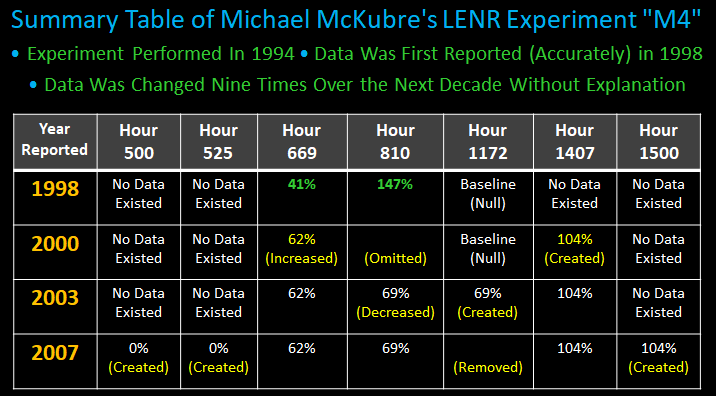
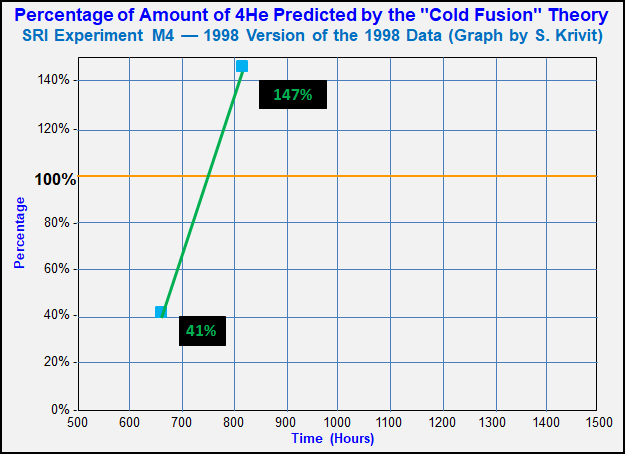
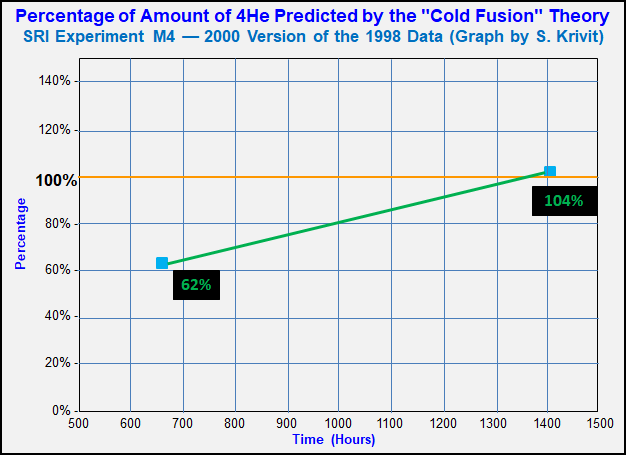
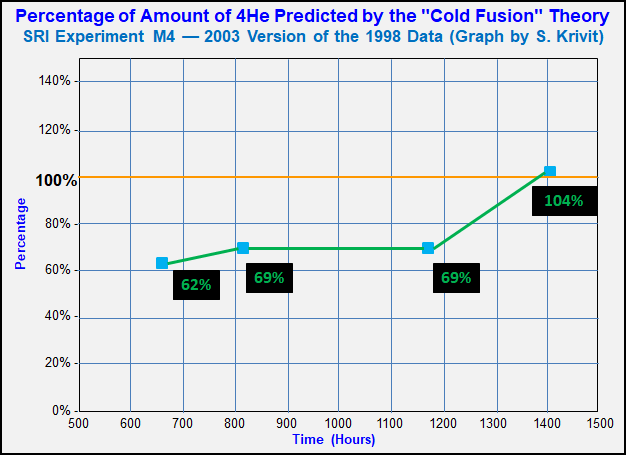
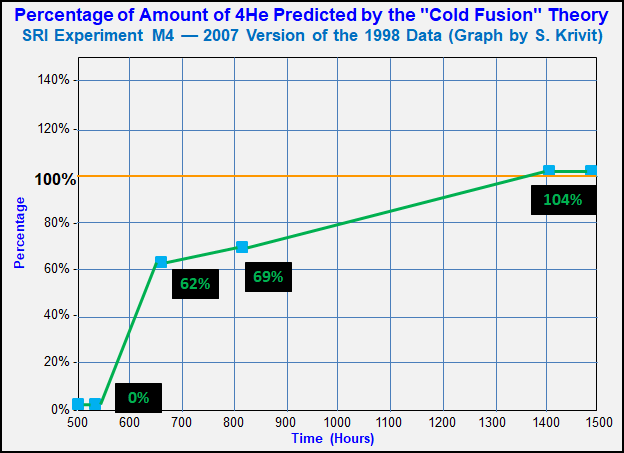
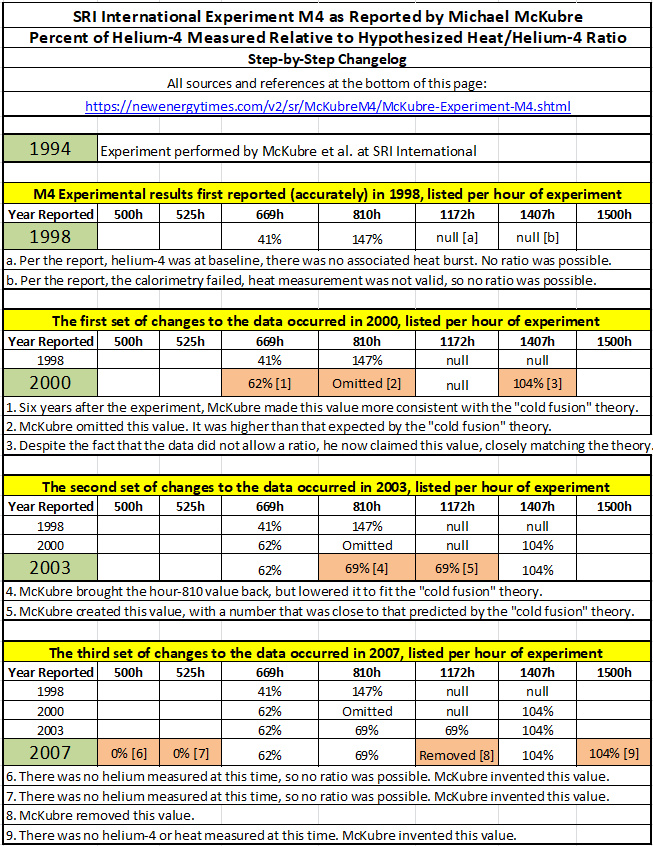
By Steven B. Krivit
Introduction
Michael McKubre is an electrochemist who worked at SRI International, in Menlo Park, California, from 1978 to 2016. He is a pioneer in the LENR field.
Starting in the early 1990s, he managed an SRI laboratory called the Energy Research Center and held the title of director. The lab was funded with several million dollars, some of it from the Defense Advanced Research Projects Agency (DARPA). Funding also came from the Electric Power Research Institute (EPRI), a nonprofit organization funded by the electric utility industry.
McKubre and his team performed some of the most important experimental research in the field, independently replicating positive results of other researchers in the field. One such experiment was an electrolysis experiment, in which they analyzed for and measured excess heat and helium-4. This experiment was known as "M4."
Thanks to McKubre's research, his affiliation with the prestigious SRI International, and his eloquence, McKubre, more than anyone else, was often asked to speak for and represent the field. This article goes into more detail about why he was regarded as a hero in the field.
McKubre's M4 as Reported in 1998
Because other reaction products in LENR experiments besides helium-4 are associated with the production of excess heat, the equation D+D → 4He + 24 MeV is irrelevant. However, knowledge of other reaction products may not have been as clear in 1994, when experiment M4 was performed at SRI international.
In experiment M4, only four helium-4 samples were taken. The complete original report for experiment M4 appears in the 379-page report from the Electric Power Research Institute (EPRI) titled "Development of Energy Production Systems From Heat Produced in Deuterated Metals, Volume 1, TR-107843-V1." [1] Here are the images that identify those four helium measurements.
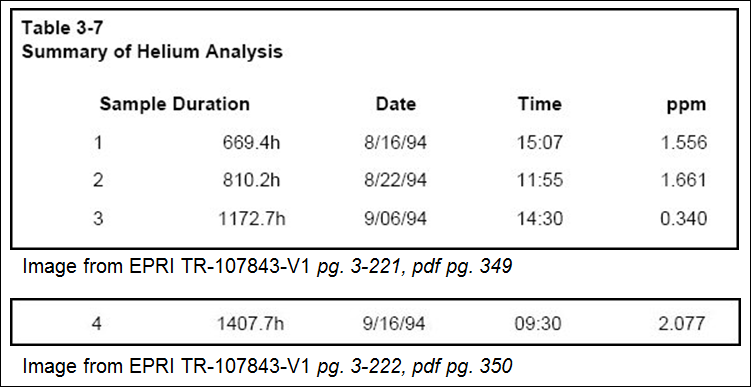
Only three heat episodes (bursts) were calorimetrically observed. I produced the graph below based on the data in the EPRI report.
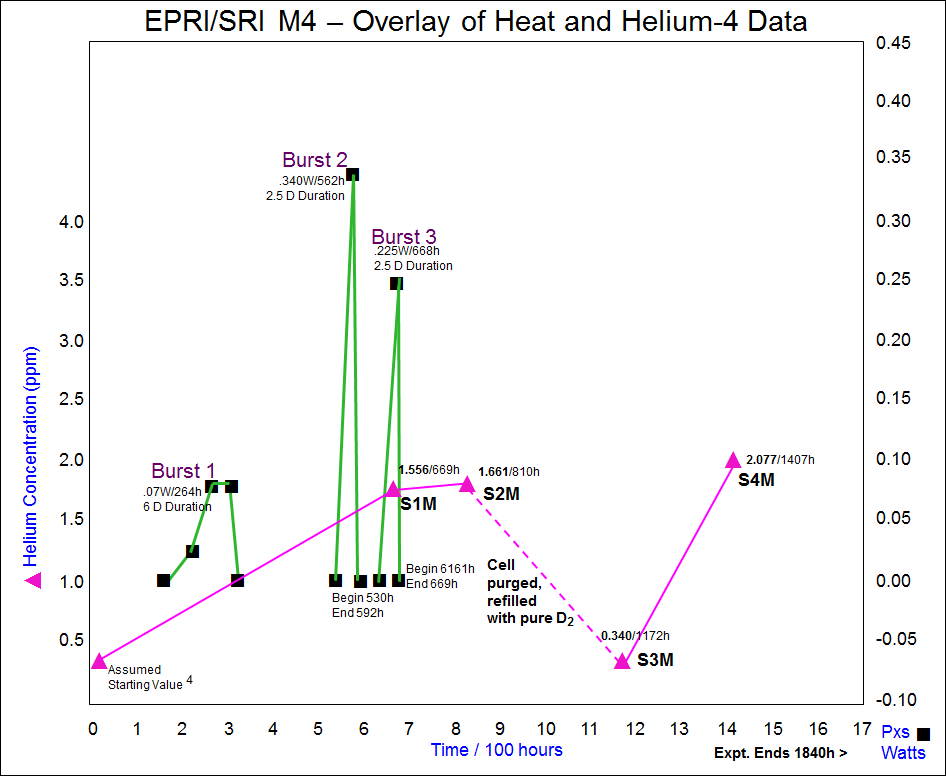
Graph produced by Steven B. Krivit from data in EPRI Report #TR-107843-V1
Helium samples were measured from the collected gases that evolved from the experiment. The first sample measured 1.556 parts per million. From this concentration, the researchers were able to calculate the quantity of helium-4 atoms produced. When they compared the measured ratio of heat to helium-4 to the hypothetical ratio (24 MeV per helium-4 atom), the authors determined that, "in Sample 1, only 41 percent of this amount was found." (See the image below.)
For the second helium sample, the ratio was too high, as the authors wrote: "Sample 2 contained 1.66 ppm, 0.53 ppm more than expected." Sample 2 was 147 percent of the hypothetical ratio of 24 MeV heat per helium-4 atom.
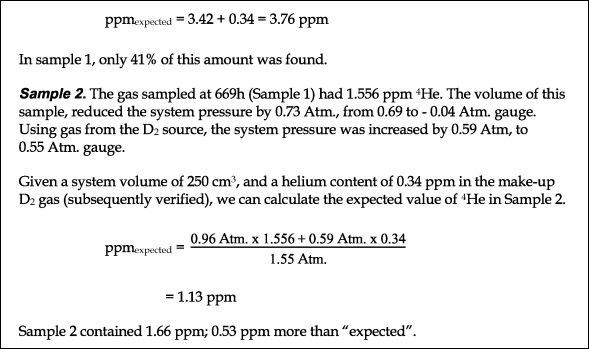
Excerpt from page 3-223 of EPRI Report #TR-107843-V1
The third sample, 0.340 ppm, was taken after the cell was purged and was effectively a baseline measurement value. From this, the experimenters concluded that "the gas in the cell was adequately purged [and that] the sampling effectively excludes room air."
The fourth sample, measured at 2.077 ppm, was a valid helium-4 measurement indicative of helium-4 produced in the cell. However, issues with the calorimetry prevented the researchers from determining a valid heat measurement during that time. As a result, the researchers — in the 1998 report — could not and did not attempt to determine a ratio between the heat and that helium-4 measurement.
To make it easy for anyone to verify the information I am presenting here, I have extracted the 13 pages from the EPRI report that contain this information and placed that excerpt online here: "Report 107843 Excerpts 4 with Markup - Discussion and Conclusions." If anyone has difficulty locating the full report, they may contact me directly.
In sum, the researchers had only two valid heat/helium-4 ratios: from Sample 1 and Sample 2.
In the 1998 EPRI report, McKubre and his team did not depict these ratios graphically; they described them only as shown in the 13-page excerpt. I'm going to present a running log, as a table, of the reported ratios listed sequentially based on time during the experiment, as they changed from year to year.
In the 1998 report, Sample 1 (41%) was measured at 669 hours, Sample 2 (147%) was measured at 810 hours, Sample 3 (a baseline value) was measured at 1,172 hours, and Sample 4 (uncorrelated to heat; no ratio available) was measured at 1,407 hours.

Next, we will look at a paper McKubre presented at the biennial "cold fusion" conference in 2000. [2]. In this paper, he provided a ratio for Sample 1, but instead of listing it at 41%, he listed it as 62%. Instead of displaying the Sample 2 value (147%), which was too high, he simply omitted it. For Sample 3, which was just a baseline helium-4 value, not a ratio, he provided an accurate explanation. For Sample 4, he provided a heat-to-helium-4 ratio of 104%, despite the fact that he had no valid heat measurement for that portion of the experiment.

At the biennial "cold fusion" conference in 2003, McKubre displayed the ratios graphically for the first time. [3] In the graph below, McKubre visually depicted and labeled Sample 1 as 62%, Sample 2 as 69%, and Sample 4 as 104%. He visually depicted Sample 3 at its measured ppm value of 0.34 and at a ratio value of 69%. McKubre's 2003 graph is almost identical to the graph that he and Peter Hagelstein presented during the 2004 Department of Energy Review of LENRs. [4]
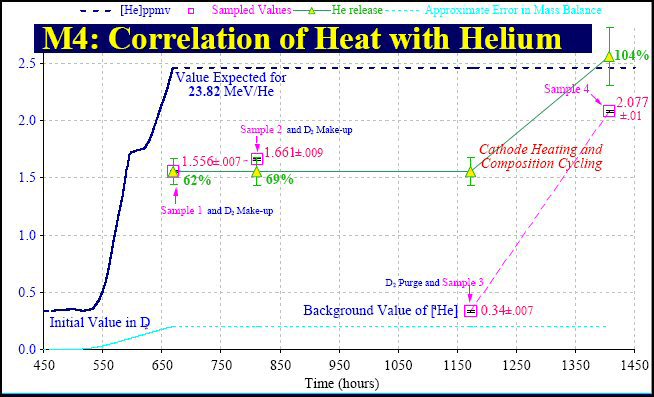
McKubre's version of the M4 measurements, as he displayed them at the 2003 ICCF-10 conference

Three years later, at the 2007 American Physical Society conference, McKubre had made lots of changes to the graph. New, unlabeled data points appear at 500 hours, 525 hours, and 1,500 hours. No helium measurements had been taken in 1994 at those times. Hence, no ratios were possible at those times. Based on the ppm measurement of 0.34, the value displayed at 525 hours appears to be the Sample 3 helium measurement that was actually measured at 1,172 hours.
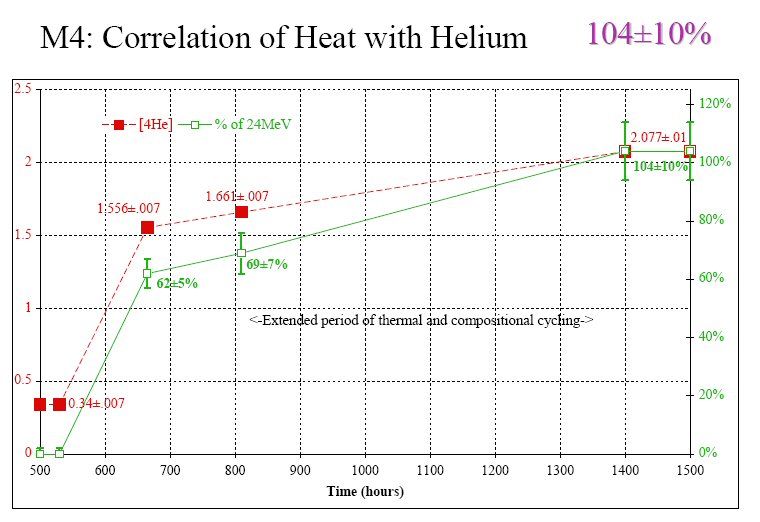
McKubre's version of the 1994 measurements, as he displayed them at the 2007 American Physical Society conference

There are other discrepancies between the 1998 report and McKubre's later presentations of experiment M4, but the ones I've shown above are the easiest to follow.
Seeking Understanding
Before I published anything about my findings in this investigation, I arranged to meet with Francis Tanzella, an electrochemist at SRI International who worked directly on the experiment. In a 2 ½-hour meeting with him, I reviewed my understanding of the experiment. Tanzella was cordial, fully cooperative, and open with me. He concurred with my analysis of every page of the M4 data in the EPRI report. I also identified two minor errors in the published EPRI report, and again, he concurred with me.
A key assertion McKubre had made in his 2000 paper was that, during the electrolysis experiment, helium-4 dissolved into and desorbed out of palladium. This is how McKubre explained the low level of helium-4 they had measured in some of the samples. It would not explain the too-high level measured in S2. During my meeting with him, Tanzella told me that helium did not dissolve into metal. I had already researched the behavior of helium in metals and knew that Tanzella was correct. When we got toward the end of my questions, I asked Tanzella to look at the pages of the 1998 EPRI report that discussed the helium measurements. I pointed out the discrepancies between the 1998 report of the helium measurements and the 2000 and 2003 publications of the same helium measurements. He read the relevant pages in front of me, and he could not explain the discrepancies; he was perplexed. Like me, he was at a loss for a scientific explanation of the changes. He seemed unaware of the changes that were made and said that I would have to ask McKubre because he had written the papers. He also told me that McKubre's collaborator, MIT professor Peter Hagelstein, had recently asked to see the raw data. I don't believe that Hagelstein knew what McKubre had done up until that point.
On Jan. 22, 2010, I e-mailed McKubre, as well as Ellie Javadi and Lindsay Sheppard at the SRI public affairs office, seeking an explanation for the discrepancies. None of them responded.
On March 21, 2010, I had the opportunity to ask McKubre about experiment M4 face to face. The American Chemical Society meeting was taking place in San Francisco, California. The ACS had organized a "cold fusion" press conference. When I asked McKubre about M4, he said that sometime after 1998 he had found "an error" (just one) in the original 1998 report and that he had sent notice of that error to EPRI, the sponsor of the research. When I later checked, neither of the two EPRI program managers involved in that project was aware of any correction or errata.
But by the day after I questioned McKubre during the press conference, experiment M4 had been expunged. McKubre had mentioned experiment M4 in possibly every conference presentation since 2000. For the first time in a decade, without any notice, let alone formal retraction, McKubre had failed to mention his D + D —> Helium-4 + 23.8 MeV heat claim, let alone say that experiment M4 provided its proof. M4 had disappeared silently at 4:29 p.m. on March 22, 2010, when McKubre concluded his conference presentation.
Postscript 2023: Francis Tanzella, the person in the lab who oversaw the experiment and a co-author on the related papers, also denied knowledge of any correction. "To the best of my knowledge, there were no further written reports regarding M4 sent to any one in writing." (Experiment M4 — Record of Discussion with Francis Tanzella)
Experiment M4 - Before and After
References
1. Development of Energy Production Systems From Heat Produced in Deuterated Metals - Energy Production Processes in Deuterated Metals, Volume 1, TR-107843-V1, Thomas Passell (Project Manager), Michael McKubre, Steven Crouch-Baker, A. Huaser, N. Jevtic, S.I. Smedley, Francis Tanzella, M. Williams, S. Wing (Principal Investigators), B. Bush, F. McMohon, M. Srinivasan, A. Wark, D. Warren (Non-SRI Contributors), (June 1998)
2. Michael McKubre, Francis Tanzella, Paolo Tripodi and Peter Hagelstein, "The Emergence of a Coherent Explanation for Anomalies Observed in D/Pd and H/Pd Systems; Evidence for 4He and 3He Production" 8th International Conference on Cold Fusion. Lerici (La Spezia), Italy: Italian Physical Society, Bologna, Italy, (2000)
3. Michael McKubre, "Review of Experimental Measurements Involving DD Reactions (PowerPoint Slides)," in Tenth International Conference on Cold Fusion, Cambridge, MA (Aug. 2003)
4. Peter Hagelstein, Michael McKubre, David Nagel, Talbot Chubb, Randy Hekman, "New Physical Effects in Metal Deuterides," Submitted to the 2004 U.S. Department of Energy LENR Review, (2004) |

